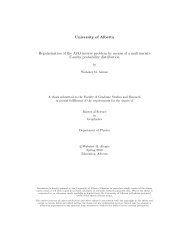Soner Bekleric Title of Thesis: Nonlinear Prediction via Volterra Ser
Soner Bekleric Title of Thesis: Nonlinear Prediction via Volterra Ser
Soner Bekleric Title of Thesis: Nonlinear Prediction via Volterra Ser
You also want an ePaper? Increase the reach of your titles
YUMPU automatically turns print PDFs into web optimized ePapers that Google loves.
4.3. NONLINEAR PREDICTION OF COMPLEX WAVEFORMS 55<br />
Time (s)<br />
0<br />
0.2<br />
0.4<br />
0.6<br />
Traces<br />
20 40<br />
(a)<br />
Time (s)<br />
0<br />
0.2<br />
0.4<br />
0.6<br />
Traces<br />
20 40<br />
Figure 4.4: (a) <strong>Prediction</strong> <strong>of</strong> Figure 4.2(b) (p = 6). (b) The error between original<br />
data and predicted data.<br />
with additive noise. The prediction for different filter lengths cannot model the<br />
data (p = 3, 5, and 15) in Figures 4.8, 4.9, and 4.10; p = 5 rejects noise but cannot<br />
model the data; p = 15 models the data better than the optimum filter length<br />
but it is also not a perfect solution because it overfits noise in the prediction panel<br />
(Figure 4.10(b)).<br />
Events with nonlinear moveout can be modeled with a <strong>Volterra</strong> series. I begin<br />
by considering equation (4.8) as a <strong>Volterra</strong> series expansion by appending nonlinear<br />
coefficients. Remember that although the data vector m in equation (3.25) contains<br />
linear and nonlinear prediction coefficients, the problem is linear in the coefficients.<br />
(b)









